Evolving the Role of Equines
Many of us on the Natural Lifemanship team have been working with equines for decades. We’ve spent much of that time preparing mustangs for domestic life, training horses for ranch work, and partnering with them for equine assisted services.
Long ago, we moved away from a traditional utilitarian approach to horses, and toward a perspective that seeks to engage horses without the need for fear, domination, and control. This launched the unique approach of Natural Lifemanship (NL) that has flipped the script on how equines participate in healing services.
Understanding Equines as Sentient Partners
Natural Lifemanship developed a way of thinking about how the equine is involved in therapeutic settings that includes the equine’s unique contributions as an individual.
Not all equines are the same, just like all people are not the same.
This consideration, of how each participant in a session contributes to the stability or instability of that session, is necessary for providing ethical treatment. Neither the equine, nor any facilitators, are exempt.
Get to Know the Treatment Team
Today we are sharing what we have named the Jobe Treatment Ratio —a framework for considering all the individuals in a therapeutic session, including the equine.
The Jobe Treatment Ratio is an attempt at providing a more concrete way to conceptualize the complex fluid relational development between all those involved in a given session, and to recognize how that relationship determines the level of care the team can provide to clients. This model is still oversimplified in many ways, but hopefully provides a snapshot of the complex relational interactions that are flowing through every moment.
For simplicity, this model assumes a session involving a licensed or certified co-facilitator, equine professional, horse, and client. These roles may differ in reality and therefore the model can be adjusted to help you conceptualize any specific situation.
When you think about the four individuals involved, then you can start to separate, on a simplistic level, who is there to receive services (client) and who is there to provide services (facilitators).
Facilitators engage in months, if not years, of training and supervision in order to offer services to clients ethically. A client and their facilitators often, either formally or informally, arrive at a social contract of expectations for services, sometimes called an informed consent. This agreement sets a framework for guiding the professionals in decision-making throughout the process of providing services.
Hopefully, it is clear that the equine professional and therapist are providing services and the
client is receiving. This scenario would create a 2:1 treatment ratio for a session, two individuals providing services for one.
Where Does the Horse Fit In?
Equine Assisted Services are unique – involving not only the professionals and the client, but one or more equines as well.
So what about the horse in this scenario? On which side of this ratio does the horse fit?
A horse is not developed in the same way humans are and does not have to commit to a social contract in order to provide or receive services. And yet they are part of this interaction. The question then becomes, are they there to provide services or receive services?
Well, the answer is complex and fluid from individual to individual—and truly, moment to moment. As humans, we determine our ability to provide services according to the guidance of professional structures and assessments we have created and maintained as a society—as well as in assessing our own personal development. We attempt to determine the ability of equines in similar ways. The development of each horse and human will determine whether or not they are mostly providing services or mostly receiving services. As the moment and environment change, so too do the abilities of each individual involved. This is the complex nature of relational interactions.
Each individual offering services requires a foundation for understanding the ins and outs of a session, knowing what is expected of them, and having a strong level of communication with other partners.
If the social contract is that the EP and co-facilitator are there to provide services for the client and involve the horse in that process, then it stands to reason that the horse could be part of the treatment team. Proper development of the horse’s thinking skills are necessary for him to be a valid partner on the treatment team. This is not easy, but is possible.
It is important to ask, can this horse consent to participation? Can this horse move freely, think freely, and communicate freely? Can this horse understand the expectations of the session? If you can answer yes to these questions (and others), it is possible for this horse to be a partner in the treatment team.
An Ideal Ratio for Treatment
If the answers above are “yes,” then we have the possibility of a 3:1 treatment ratio, where 3 individuals (EP, co-facilitator, and horse) are supporting and providing services for 1 client.
Vital to the quality of services that are offered is the relational development between these three members of the treatment team. This relationship cannot be picked up and put down at will. Conscious effort and ongoing team development are necessary.
The model below for the 3:1 ratio represents just one of an infinite number of ways this could look. If we have done significant work with EP, co-facilitator, and horse, then they can all work in unison to serve the client and you have an understanding and communication about how they are achieving this in every moment.
Yes, we contend that equines can develop to this level. It takes intentional practice, building an equine’s ability to maintain his sensitivity and think for himself, which is only possible when we let go of outdated ideas of domination and control in human-horse interactions.
Notice in the diagram below, the quality of therapeutic or “safe” space made possible when the horse, equine professional and co-facilitator are well-developed as a team. Maintaining connection in a well established relationship takes little energy, while building connection in a newer relationship can require much more attunement, focus, and regulation.
In a well developed ratio of 3:1, the treatment team has significant energy free to devote to the client, rather than diverting it to support each other during a session.
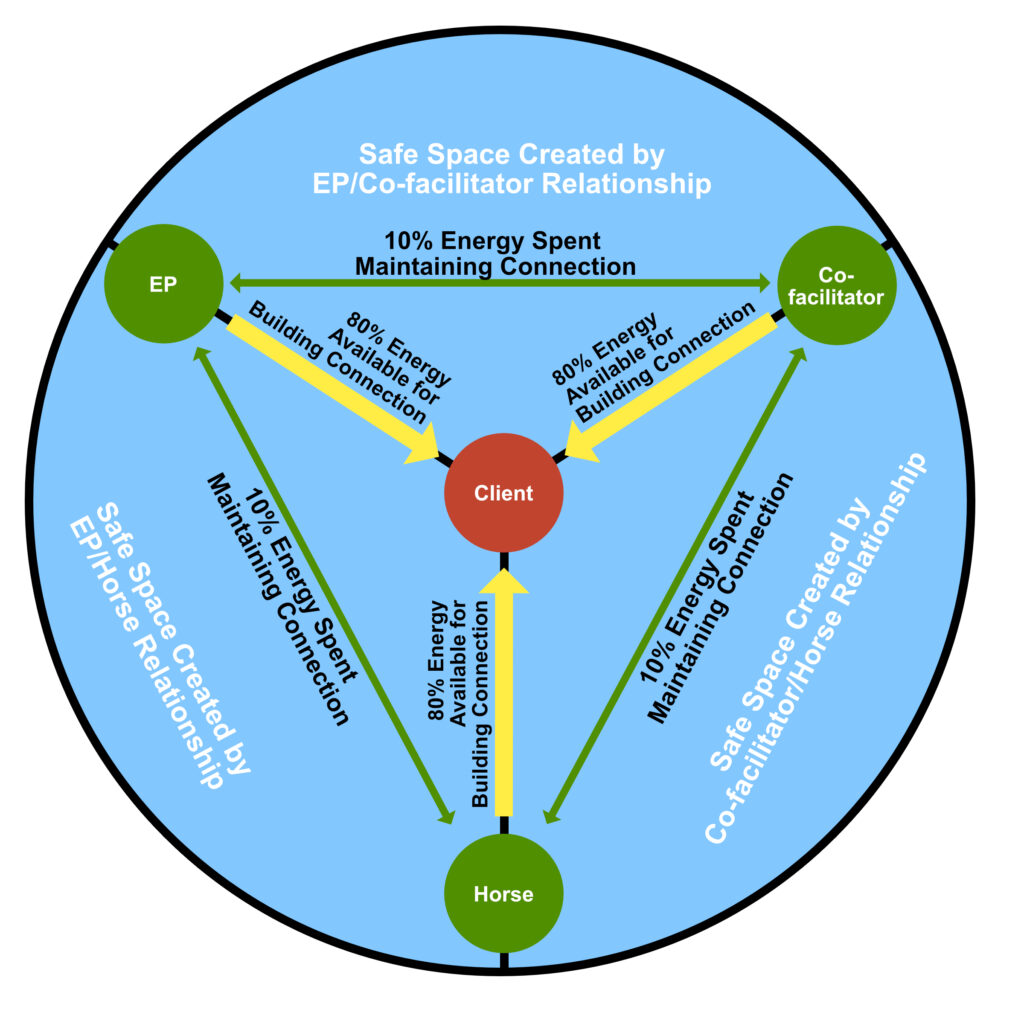
When the Horse is Not a Part of the Treatment Team
We would say that it is more common that equines in these settings have not yet developed enough to easily create and sustain connection with others while maintaining their own autonomy. Therefore, they are unable to hold the same understanding as the EP and co-facilitator in a therapeutic setting.
If, as is common, the horse has not yet developed this skill set, then a closer representation would be a 2:2 treatment ratio. With a 2:2 treatment ratio, the EP and co-facilitator are having to extend themselves a bit more to provide support for the client as well as the horse in session.
The 2:2 model below shows one way that this could look. Notice the shift in energy and focus particularly for what the Equine Professional can offer the client, as well as what the horse can offer the client.
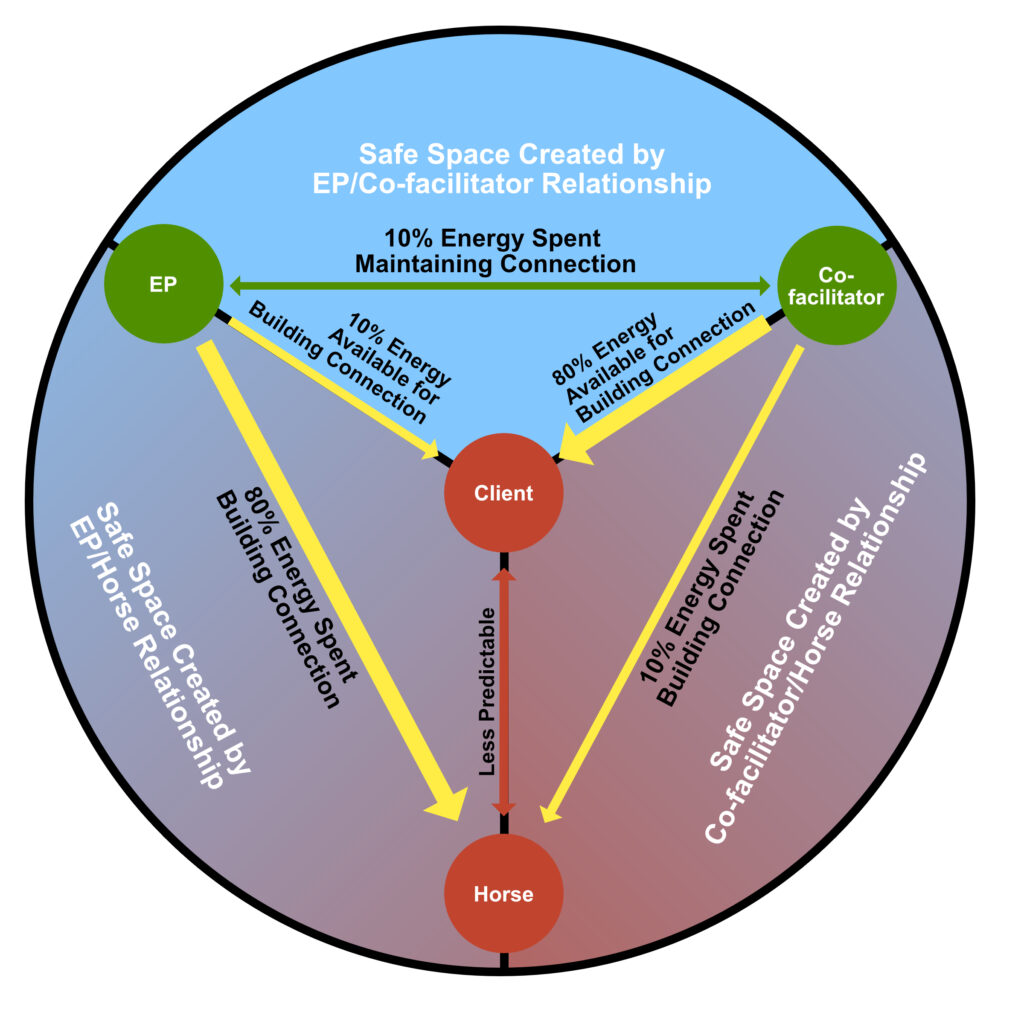
In a Less Developed Team
Finally, if the humans in the treatment team are not well developed (either personally or relationally) we may devolve into a situation where each member believes they are having to support and offer treatment to everyone else involved. Then the situation may more closely resemble the dreaded 1:3 ratio.
At this ratio, we are doing our clients a real disservice. Below is one way this could be represented. It is referred to as the model of the 1:3 ratio.
Keep in mind this is one way this situation could evolve. There are many other possibilities, including if the co-facilitator is less experienced working experientially, working with horses, or working in a team. Their energies may be less predictable as well.
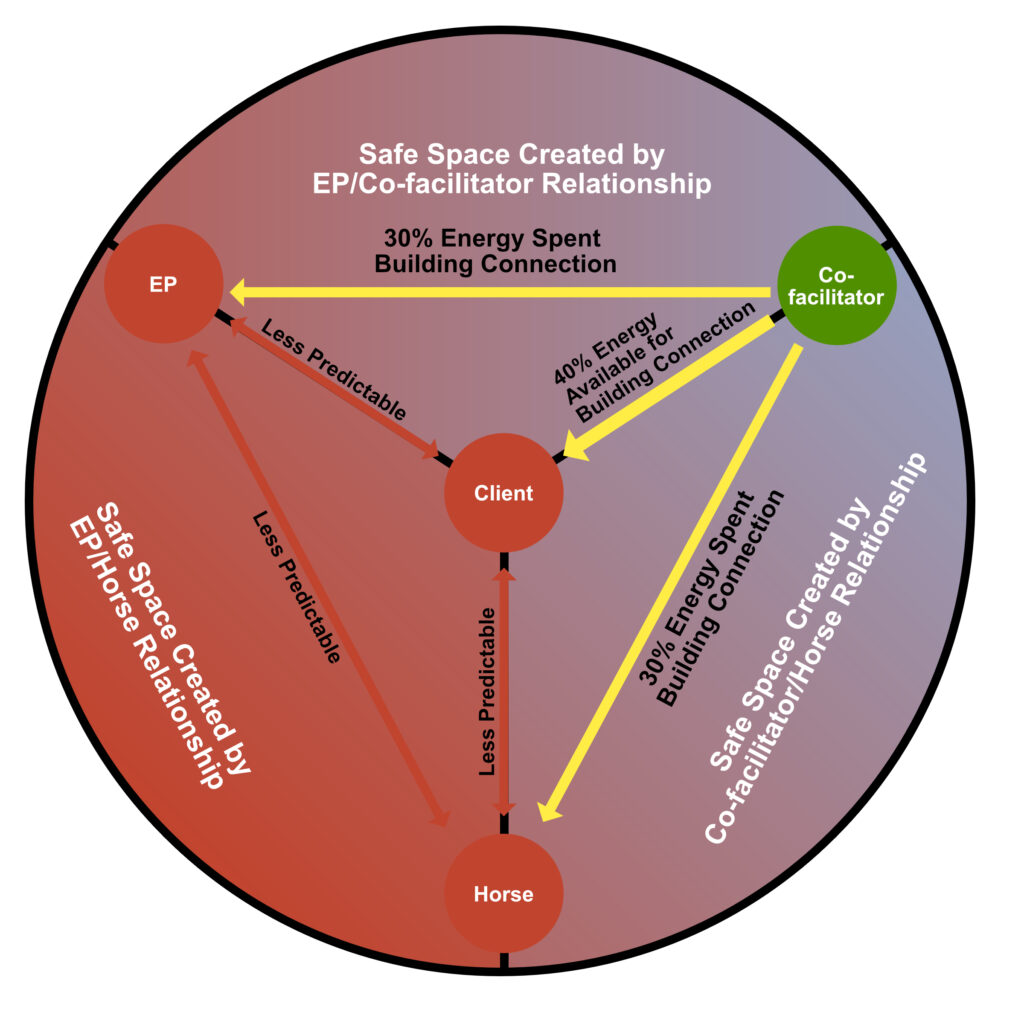
You can also see how the quality of the relationship between the members of the treatment team affects each member’s ability to offer support to the client. Notice how it affects the ability of the team to create a safe space for the client. The cohesiveness, personal development, and team communication present in a treatment team vastly influences the quality of services offered.
Assess Your Team
Insert your treatment team into this model and determine what your development and percentages might be. Notice which human-horse combinations put you at a 3:1 treatment ratio and which combinations put you at a 2:2 ratio. Also, consider scenarios that would put you at 1:3 and work on growing out of those.
This should help you and your team grow together towards that ideal 3:1 ratio. Perhaps in exploring these ratios, you and your team will pinpoint a few of the areas that may need more work outside of the session.
Also consider how things change (dramatically!) if you include more than one equine, or more than one client. This is why, ethically, it may not make sense for a facilitator to work without an EP—or for only one or two professionals to offer services to big groups of people and/or equines. Imagine the complex web of energy necessary for providing connection and a safe space to a whole family, group, or herd!
Each facilitator, equine professional, equine, and client will come with their own histories, tendencies, and needs. Hopefully, the professionals also come with a clear self-awareness and understanding of their equine’s abilities and limitations so as to create an ethical therapeutic environment.
While this concept of ratios is simplified, it should make the ideas adaptable to whatever scenario you find yourself in, helping you and your team gain greater awareness of where your energy is going during a session and how you can all develop toward a ratio that better supports your clients.
Learn more in Our Upcoming Webinar
Tanner Jobe will be hosting a webinar on August 3, 2022, at 5pm CST where he explores the ratios illustrated above, and answers your questions. This is a great opportunity to dive more deeply into the concepts presented here. Sign up here.

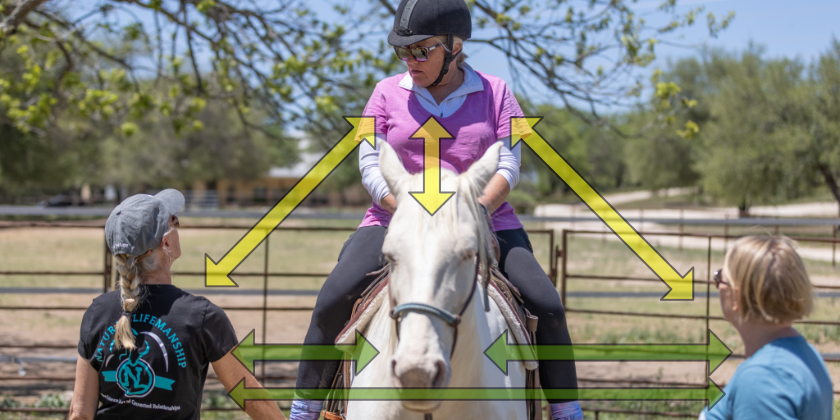
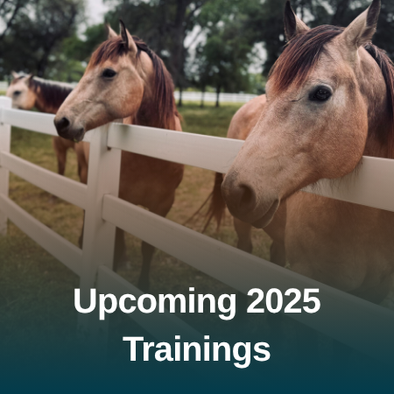
Recent Comments